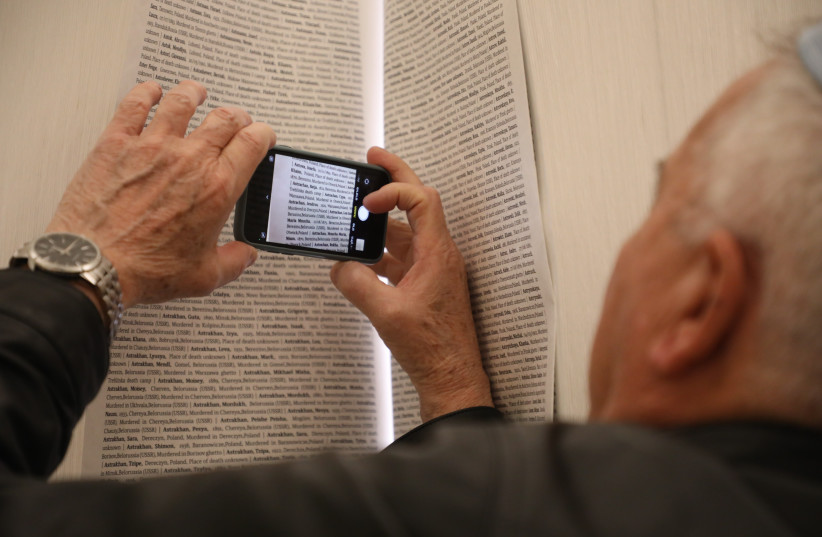Nakhman Skariton. Arie Skariton.
These two names, two brothers murdered during the Holocaust, are known today thanks to two Pages of Testimony submitted to Yad Vashem, the World Holocaust Remembrance Center in Jerusalem, by their sister, Dina Elkis, who survived the Shoah. From Elkis’s testimony, we also know that they were born in Zhashkiv, Ukraine, and in June 1942, after being led to a pit in Warkowice, Poland, they were shot dead by German Nazis.
These are just two of the 2.7 million Pages of Testimony on record at Yad Vashem that have been painstakingly collected over the past seven decades. In addition to these, Yad Vashem has gathered and meticulously reviewed millions of documents and historical records revealing another 2.1 million names of Jews brutally murdered during the Shoah by Nazi Germany and its collaborators.
These two young men who were shot in cold blood in the prime of their lives are particularly significant to me because they were my great-uncles. Nakhman and Arie Skariton were my grandmother’s brothers. These were people I grew up hearing about but never met because they were the unlucky few members of my family who remained behind in Europe after the Nazi rise to power.
These are the names, as Jewish tradition dictates, that have since been incorporated into nearly every branch of my family tree, either as a first or second name. For me, these names are associated with pain and loss and sorrow, and they serve as a reminder of the millions of Jews who suffered similar, terrible fates. All these names deserve to be remembered.

Remember the names of Holocaust victims
The name of the esteemed institution I am honored to head, Yad Vashem, quite literally means “a memorial and a name” in English. Since its inception in 1953, Yad Vashem has gathered 4,800,000 names of Jewish men, women and children murdered during the Shoah – creating the world’s most comprehensive record of Holocaust victims.
The Central Database of Shoah Victims’ Names, which is accessible online on Yad Vashem’s website (in six languages), has been transformed into a new exhibit that is now part of the permanent display at Yad Vashem on Jerusalem’s Mount of Remembrance.
The Book of Names of Holocaust Victims is the single largest physical manifestation of remembrance of its kind. The Book of Names, which was inaugurated this week at Yad Vashem in the presence of Israel’s President Isaac Herzog, Chairman of Yad Vashem Council Rabbi Israel Meir Lau, and myself, contains the birth dates, home towns, and circumstances and places of death of the respective victims – when known.
Visitors to the Mount of Remembrance can now physically touch those names and search through them to find the records of family members and friends – or simply to connect with their Jewish brothers and sisters whom they never met but whose loss they continue to mourn.
This past June, I visited the site of the infamous former concentration and extermination camp Auschwitz-Birkenau, where over one million Jewish men, women and children were gassed, starved, shot and beaten to death. There, I was able to leaf through the pages of the previous version of the Book of Names (containing 4.3 million names), on display at Yad Vashem’s “Shoah” permanent exhibition in Block 27 in the Auschwitz-Birkenau State Museum, and connect physically to the memory of my dearly departed family members.
THE NEW Book of Names, now housed at Yad Vashem, was first displayed two months ago at the UN Headquarters in New York as part of the activities marking this year’s UN-sanctioned International Day of Commemoration in Memory of the Victims of the Holocaust, marked each year on January 27– the anniversary of the liberation of Auschwitz-Birkenau. There, UN Secretary General António Guterres and I were humbled to present this unique exhibit to diplomats and opinion-makers from across the globe.
History never repeats itself exactly, but the phenomena of extreme antisemitism and other racial hatreds, aggressive violence and corrupt dictatorships are recurring. In order to combat and overcome them, we can, and must, learn from the Shoah. And we start that by faithfully and accurately remembering its victims. That is why the Book of Names is here now.
Every Jew murdered during the Holocaust had a name, a face and a unique life story. They were not anonymous victims – as the Nazi Germans wanted us to see them. Seventy years later, our duty remains to continue to search every archive, scour every source of documentation, and turn every stone in order to retrieve every last name that can be rescued from oblivion. The Book of Names exhibit comes to restore in black and white the identity of those murdered Jews, and to allow the world to realize that they were not just victims but also human beings, like you and me.
We can never recover the loss of the six million, but we can and must do everything to try to restore the names of the individuals – along with their values, their aspirations and their achievements.
This new Book of Names was produced thanks to the generous support of Yad Vashem Visionaries Marilyn and Barry Rubenstein (US). For more information about the Book of Names, visit: yadvashem.org
The author is chairman of Yad Vashem since August 2021. Previously, he served as the consul-general of the State of Israel in New York between 2016-2020.
